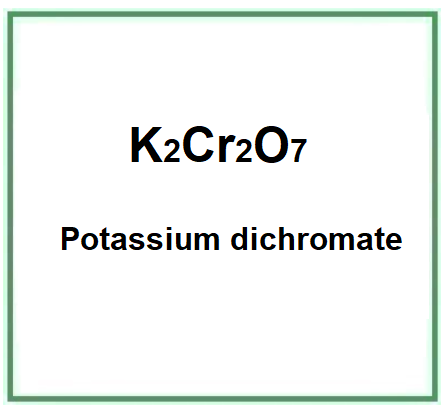Potassium dichromate is an inorganic chemical compound, the potassium salt of dichromic acid.
It appears as a powder or reddish liquid soluble in water.

What it is used for and where
An oxidising compound that emits toxic chromium vapours when heated. Highly corrosive and irritating.
Cosmetics
It is a restricted ingredient II/97 and classified as carcinogenic 1B a Relevant Item in the Annexes of the European Cosmetics Regulation 1223/2009 and 2004/93/EC
Safety
It is believed to be highly cytotoxic to liver cells and can cause DNA damage (1), an ophthalmic allergen (2) and can cause allergic contact dermatitis (3).

Other uses
- wood preservative and stain
- disinfectant for swimming pool cleaning
- oxidising agent in laboratory wet test applications for its non-hygroscopic properties
- retarding agent for cement
- cofactor in the production of potassium chromium, chromium oxide, yellow chromium pigment
- key ingredient in the production of match tips
- Molecular Formula Okay2Cr2O7 Cr2Okay2O7 K2Cr2O7
- Peso molecolare 294,18 g/mol
- CAS 7778-50-9
- UNII T4423S18FM
- EC Number 231-906-6
References_____________________________________________________________________
(1) Patlolla AK, Barnes C, Hackett D, Tchounwou PB. Potassium dichromate induced cytotoxicity, genotoxicity and oxidative stress in human liver carcinoma (HepG2) cells. Int J Environ Res Public Health. 2009 Feb;6(2):643-53. doi: 10.3390/ijerph6020643.
Abstract. Chromium is a widespread industrial waste. The soluble hexavalent chromium Cr (VI) is an environmental contaminant widely recognized to act as a carcinogen, mutagen and teratogen towards humans and animals. The fate of chromium in the environment is dependent on its oxidation state. Hexavalent chromium primarily enters the cells and undergoes metabolic reduction to trivalent chromium, resulting in the formation of reactive oxygen species together with oxidative tissue damage and a cascade of cellular events. However, the results from in vitro studies are often conflicting. The aim of this study was to develop a model to establish relationships between cytotoxicity, genotoxicity and oxidative stress, in human liver carcinoma [HepG2] cells exposed to potassium dichromate. HepG2 cells were cultured following standard protocols and exposed to various concentrations [0-50 microM] of potassium dichromate [K2Cr2O7]. Following exposure to the toxic metal, the MTT assay was performed to assess the cytotoxicity, the thiobarbituric acid test to evaluate the degree of lipid peroxidation as an indicator of oxidative stress and the alkaline comet assay was used to assess DNA damage to study genotoxicity. The results of the study indicated that potassium dichromate was cytotoxic to HepG2 cells. The LD(50) values of 8.83 +/- 0.89 microg/ml, 6.76 +/- 0.99 microg/ml, respectively, for cell mortality at 24 and 48 hrs were observed, indicating a dose- and time-dependent response with regard to the cytotoxic effects of potassium dichromate. A statistically significant increase in the concentration of malondialdehyde [MDA], an indicator of lipid peroxidation, was recorded in exposed cells [15.9 - 69.9 microM] compared to control [13 microM]. Similarly, a strong dose-response relationship (p<0.05) was also obtained with respect to potassium dichromate induced DNA damage (comet assay) in HepG2 cells exposed [3.16 +/- 0.70 - 24.84 +/- 1.86 microns - mean comet tail length]; [12.4 +/- 1.45% - 76 +/- 1.49%-% tail DNA] to potassium dichromate than control [3.07 +/- 0.26 microns--mean comet tail length]; [2.69 + 0.19%-% Tail DNA], respectively. The results demonstrated that potassium dichromate was highly cytotoxic to HepG2 cells, and its cytotoxicity seems to be mediated by oxidative stress and DNA damage.
(2) Herbst RA, Uter W, Pirker C, Geier J, Frosch PJ. Allergic and non-allergic periorbital dermatitis: patch test results of the Information Network of the Departments of Dermatology during a 5-year period. Contact Dermatitis. 2004 Jul;51(1):13-9. doi: 10.1111/j.0105-1873.2004.00334.x.
Abstract. Periorbital dermatitis is common and can be due to the external use of ophthalmic drugs. We evaluated patch test results of the Information Network of the Departments of Dermatology. During a 5-year period (1995-99), of a total 49,256 patch-tested patients, 1053 (2.1%) were eventually diagnosed as allergic periorbital contact dermatitis (APD) and 588 (1.2%) as non-allergic periorbital dermatitis (NAPD). Patient characteristics between APD, NAPD and other cases (OCs) differed with respect to sex (19.7% male in both periorbital groups versus 36.3% in OCs), atopic dermatitis (10.4% in APD versus 60.2% in NAPD versus 16.9% in OCs) and age, APD being substantially more often (68.2%) aged 40 and above than NAPD (52.6%). Several of the top allergens in OCs [such as fragrance mix, Myroxylon pereirae resin (balsam of Peru), lanolin alcohol and potassium dichromate] caused significantly fewer positive test reactions in both periorbital groups. In contrast, thimerosal, phenylmercuric acetate, sodium disulfite, gentamicin sulfate, phenylephrine hydrochloride and benzalkonium chloride tested positively significantly more often in APD but not in NAPD, verifying them as true ophthalmic allergens. Finally, in 42 cases (4%) of APD patients, additional allergens were identified by testing of the patients' own substances (mostly beta-blockers, oxybuprocaine and dexpanthenol), supporting the necessity of testing with ophthalmic drugs as is where individual substances are not readily available.
(3) Navarro-Triviño FJ, Prados-Carmona Á, Velasco-Amador JP, Ruiz-Villaverde R. Bullous Allergic Contact Dermatitis Caused by Potassium Dichromate. Sultan Qaboos Univ Med J. 2023 Feb;23(1):127-128. doi: 10.18295/squmj.5.2022.037.
![]() Potassium dichromate
Potassium dichromate 







